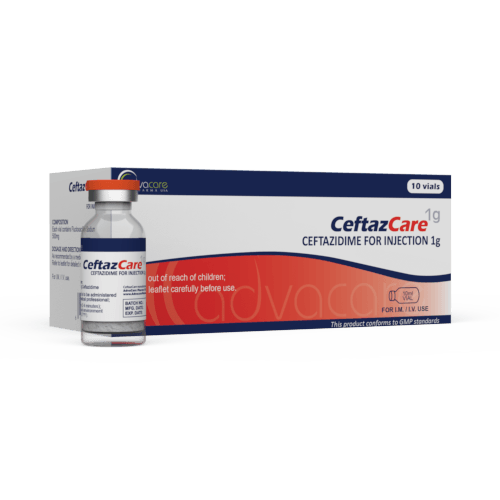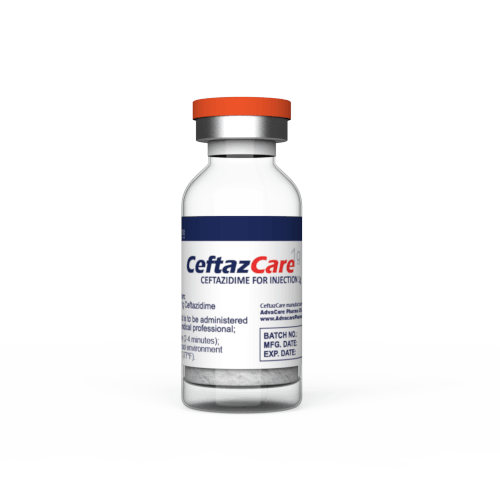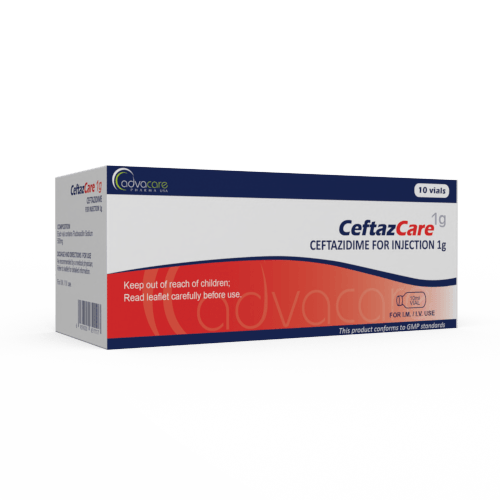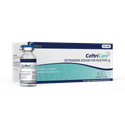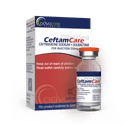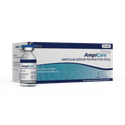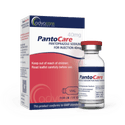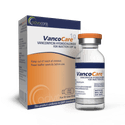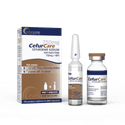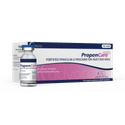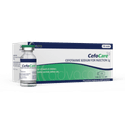- Home›
- Pharmaceuticals›
- Injections›
- Powder for Injection›
- Ceftazidime for Injection
Ceftazidime for Injection
Dosage
Packaging
What is Ceftazidime?
Active Ingredients: Ceftazidime
Ceftazidime for Injection is an antibiotic used to treat many types of bacterial infections. It is indicated for the treatment of infections in the urinary tract, skin and soft tissues, bones, and joints. Ceftazidime is also used to treat respiratory infections like pharyngitis, bronchitis, and bronchopneumonia.
Ceftazidime is classified as a broad-spectrum cephalosporin antibiotic. It works by weakening bacterial cell walls, which eventually kills the bacteria.
This is a semisynthetic, broad-spectrum antibiotic which has a bactericidal activity. Its bactericidal activity is through inhibition of the enzymes responsible for cell-wall synthesis in bacteria which are penicillin-binding proteins. It has a resistance against numerous beta-lactamases and has a broad spectrum activity against Gram-negative bacteria, like Pseudomonas aeruginosa. It can be effective against Citrobacter spp., Enterobacter spp., Klebsiella spp., Proteus spp., Serratia spp., Escherichia coli, Haemophilus influenzae, Neisseria meningitidis, Pseudomonas aeruginosa, and some Gram-positive bacteria including certain strains of Staphylococcus spp. and Streptococcus spp. Also, it can be helpful in the treatment process of Acinetobacter baumannii and Neisseria gonorrhoeae.
Bacteria in the affected organisms build a cell wall reinforced by penicillin-binding proteins. Derived from the fungus Cephalosporium sp., Ceftazidime operates through its beta-lactam ring, binding to the penicillin-binding protein and hindering normal bacterial activity. This inhibition prevents the synthesis of a cell wall, ultimately leading to bacterial death.
Staphylococcus aureus can develop resistance to Ceftazidime by modifying penicillin-binding proteins through a gene. This modification renders the antibiotic incapable of deactivating the bacteria-binding protein, resulting in methicillin-resistant Staphylococcus aureus (MRSA). Notably, Ceftazidime, belonging to the third generation of cephalosporins, does not provide coverage against MRSA.
Ceftazidime can be administered intramuscularly or intravenously. When administered intramuscularly, it should be done through a large muscle mass. The recommended intramuscular route is through the upper outer quadrant of the gluteus maximus or the lateral thigh. The intravenous route represents injections or infusions over 15 to 30 minutes. When the intravenous route is not possible or not appropriate for the patient, the intramuscular route should be chosen.
Post-administration, Ceftazidime effectively penetrates various body fluids, especially in cases of inflammation, including the cerebrospinal fluid, for treating meningitis.
The antibiotic is primarily excreted through urine, requiring proper dosage adjustments, particularly in individuals with renal insufficiencies. After administration, 20-36% of intravenous Ceftazidime is excreted unchanged, and 15-25% is a desacetyl derivative, contributing to bactericidal activity. Additional urinary metabolites, M2 and M3, lack bactericidal activity. Ceftazidime exhibits a short half-life of approximately 1 hour.
AdvaCare Pharma is a trusted global supplier of Ceftazidime for Injection. We offer a wide range of high-quality and cost-effective medications that are available for distribution. Our factories are GMP-certified and meet the high standards necessary to comply with WHO guidelines and standards.
Why choose us as your Ceftazidime manufacturer?
AdvaCare Pharma, a US-owned pharmaceutical company, is a manufacturer of Ceftazidime for Injection with GMP-compliant manufacturing facilities located worldwide. We conduct frequent GMP, third-party and internal facility inspections to ensure that our manufactured injectable treatments exceed the stringent requirements of importing countries and our distributors.
As a renown Ceftazidime manufacturer and global supplier of 120+ pharmaceutical injection products, our global reach extends to over 65 markets ensuring that pharmaceutical distributors, hospitals, pharmacies, NGOs and government institutions receive the quality-assured treatments they need.
Uses
What is Ceftazidime used for?
It is used to treat various types of bacterial infections, such as:
- urinary tract infections
- skin and soft tissue infections
- bone and joint infections
- upper and lower respiratory infections
- bacterial meningitis
- biliary tract infections
- otitis externa
- otitis media
- septicemia
- cystic fibrosis
This antibiotic can be used as a perioperative prophylaxis of infections in transurethral prostatectomy.
How is Ceftazidime Sodium for Injection used?
This medication is manufactured as a powder, which is packaged in a vial. As an injectable form, it is to be given directly into a vein (IV) or muscle (IM). Reconstituted solutions should be used immediately. When administered intramuscularly, it should be done through a large muscle mass. The recommended intramuscular route is through the upper outer quadrant of the gluteus maximus or the lateral thigh. The intravenous route represents injections or infusions.
What dose should be given?
Recommended dosage guidelines may vary depending on medical condition:
- For broncho-pulmonary infections in cystic fibrosis, the usual dose is 100-150mg/kg per day, divided and given every 8 hours. The maximum dosage is 9g per day.
- For febrile neutropenia, nosocomial pneumonia, bacterial meningitis, and bacteremia, the usual dose is 2g, given every 8 hours.
- For bone/joint infections and complicated infections of the skin/soft tissues or intra-abdominal system, the usual dose is 1-2g, given every 8 hours.
- For complicated UTIs, the usual dose is 1-2g, given every 8-12 hours.
- For perioperative prophylaxis, the usual dose is 1g at the time of anesthesia and then 1g after catheter removal.
- For infections treated by continuous infusion, the usual loading dose is 2g, followed by 4-6g given every 24 hours.
For infants and toddlers older than 2 months and children with a body weight less than 40kg, the usual dose is 100-150mg/kg per day, divided and given in 3 doses. The maximum dosage is 6g per day.
The exact dosage is based on the severity of the infections, age, gender, and weight. Refer to a doctor or pharmacist for guidelines on dosage.
Who can use Ceftazidime for Injection?
Ceftazidime for Injection can be administered to children older than 2 months, adults, and the elderly. The safety of this drug has not been established in neonates and infants younger than 2 months. This antibiotic is mainly given for treating bacterial infections. Special caution is advised for specific groups of patients.
Pregnant Ceftazidime for Injection should be used in pregnant women only when the benefits outweigh the possible risks. According to animal studies, there are no harmful effects during pregnancy. There are no known risks. However, this drug should be prescribed by doctors and should be reviewed by gynecologists who follow the pregnancy. This drug is not associated with any teratogenic side effects.
This drug can be excreted through the mother’s milk, but when given in small quantities at therapeutic doses, there are no side effects.
Elderly Ceftazidime is not toxic, but there is a possibility of renal toxicity, especially in older patients. Unnecessary high doses might increase the risk of ecological disturbances. There is a need for a dose reduction in acutely ill elderly patients, especially if they suffer from renal diseases. There is no hazardous age limit for administering Ceftazidime, but the dose should be adjusted according to the patient’s current health condition.
Patients on Hemodialysis During hemodialysis, the serum life of Ceftazidime is from 3-5 hours. To maintain the therapeutic dose, an additional dose should be administered after the hemodialysis. Low-flux haemofiltration requires different doses depending on the creatinine clearance.
Adults In adults, the dose of Ceftazidime depends on the current health condition of the human. Different bacterial infections require different dosing.
Can Ceftazidime for Injection be used for treating viral infections?
No, Ceftazidime is an antibiotic from the third generation of cephalosporins, and it is mainly used for treating bacterial infections. When there is a viral infection, the chances of getting secondary bacterial infections are increased. If this happens, antibiotics can be used to treat the bacterial infection. Ceftazidime should only be used if pathogens are susceptible to the antibiotic.
Other warnings
The dosing depends on the patient’s current health condition. Mild infections should be treated with lower doses, while severe infections should be treated with higher doses.
If the patient has a hypersensitivity to beta-lactam antibacterial agents, this antibiotic should be avoided. If the patient has not been treated with beta-lactam antibiotics before and develops a hypersensitivity, usage must be discontinued.
The spectrum of antimicrobial activity must be known before the treatment process starts. Antibiogram testing is recommended before administering this antibiotic.
Pseudomembranous colitis is a common side effect of many antibiotics and might even become life-threatening if not stopped on time.
This antibiotic contains sodium, and the daily allowance, according to WHO, is low. Special considerations must be taken when giving this antibiotic to patients with altered renal function.
Side Effects
As with all pharmaceuticals, some unwanted effects can occur from the use of Ceftazidime for Injection.
Common side effects include, but may not be limited to: • pain or swelling at the injection site • red streaks on the skin • signs of a fungal infection (vaginal itching, white patches on the tongue, etc.) • headache • dizziness • mild diarrhea
Serious side effects may occur. Seek medical attention if the following develop: • severe diarrhea or stomach pain • involuntary muscle movements • seizures • jaundice or other liver-related problems
For a comprehensive understanding of all potential side effects, consult a medical professional.
If any symptoms persist or worsen, or you notice any other symptoms, please call your doctor.
Precautions
Do NOT use Ceftazidime for Injection if:
- You are allergic to any of the ingredients.
- You are hypersensitive to other beta-lactam antibiotics.
Ceftazidime has the potential to enter breast milk and may impact the intestinal microbiota of the breastfeeding infant. The use of Ceftazidime during breastfeeding is generally not recommended by most healthcare professionals due to limited evidence regarding its safety in this context. It is crucial to consult with a doctor or healthcare professional before considering treatment with Ceftazidime while breastfeeding. Individual circumstances and the potential risks and benefits need to be carefully evaluated to make an informed decision regarding the use of this antibiotic during lactation.
Before treatment, consult your doctor regarding any medications you are taking to address potential drug interactions.
This medication may not be suitable for people with certain conditions, so it is important to consult with a doctor if you have any health conditions.
Patients who take this antibiotic might have a reduced ability to drive or operate machinery.
It is recommended to avoid combining Ceftazidime with Chloramphenicol due to the potential risk of drug antagonism.
Patients with renal impairment should have specially dosage adjustment because this antibiotic is excreted through the kidneys by glomerular filtration. The dose should be lower to compensate the slower excretion.
The way of administration should be chosen by the doctor.
Patients who take this antibiotic for a prolonged time should perform blood counts. Also, doctors should monitor the renal and liver function of patients with prolonged therapy. Prolonged usage might also lead to pseudomembranous colitis. In these cases, proper measures must be taken. Long treatment processes might also lead to superinfections with non-susceptible organisms.
False positive Coombs tests might be present in cases of Ceftazidime treatment.
If a dose is skipped, the treatment should continue at the next scheduled time.
If any serious side effects occur, the treatment process should be stopped, or the doses should be reduced under medical supervision.
Patients treated with Ceftazidime should not consume alcohol.
This antibiotic should be used only when prescribed by a professional.
Keep this antibiotic out of reach of children.
References
Treatment of chronic and recurrent respiratory infections with intramuscular ceftazidime
This study evaluated the efficacy of chronic and recurrent respiratory infections with ceftazidime. This research included two groups of patients or 34 patients with acute purulent exacerbations of chronic bronchitis. Twenty patients received 1g and 14 patients received 2g injections.
The other group (38 patients) had chronic recurrent respiratory infections (severe bronchiectasis due to Pseudomonas aeruginasa) and were treated with 2g of ceftazidime twice or thrice daily. Parameters like blood and sputum concentrations were measured microbiologically. The sputum concentrations after 2 doses reached 3.0mg/l after 1g, and 3.5mg/l after the 2g doses.
Sputum cultures taken before and after treatment revealed that 32 out of 34 patients with chronic bronchitis had negative cultures at the end of the treatment, although 6 experienced further infections by the 17th day of the study. Among 38 patients with relapsing infections caused by Gram-negative organisms, one patient died early in the treatment and another later on. However, 28 out of 37 patients had negative sputum cultures on day 11, and 17 out of the remaining 36 were free of infection on day 17. All recurrences were associated with Ps. aeruginosa or Ps. maltophilia.
Approximately 69% of the 69 Ps. aeruginosa strains were inhibited by 2mg/l of ceftazidime, and 91% were inhibited by 4mg/l. All 3 Ps. maltophilia strains were resistant, with MICs greater than 32mg/l.
This study shows that ceftazidime is efficient in treating respiratory infections.

You might be interested in...
Why AdvaCare Pharma?
As an industry leader, we are aware of our responsibility to provide affordable and sustainable solutions to improve healthcare worldwide.
